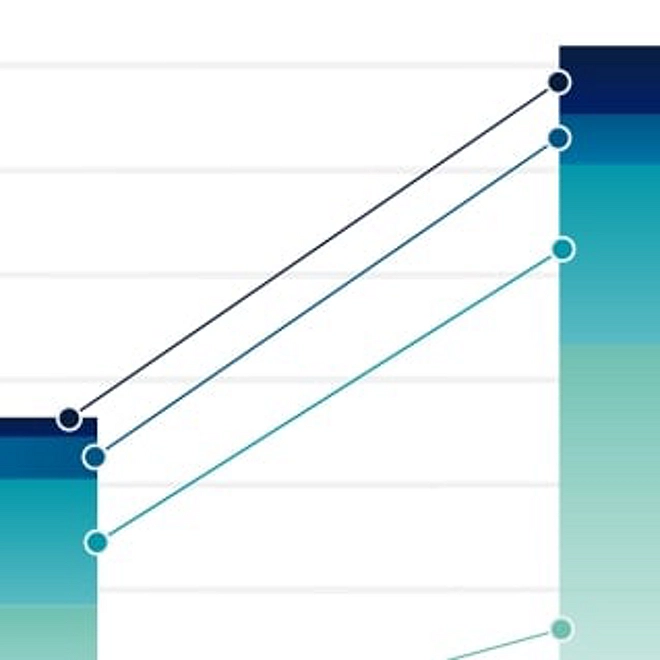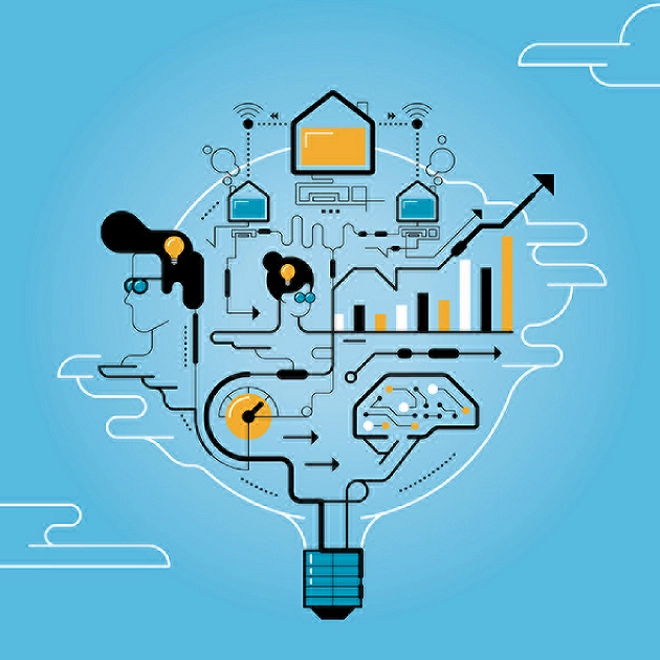CXOs and 5G edge networks
Investing today for tomorrow’s competitive advantage
As demand for more powerful networking and digital capabilities grows, 5G edge computing technologies can offer organizations the capabilities needed to unleash the next phases of innovation, efficiency, and agility. But organizations should act now to reap the benefits.
For C-suite leaders (CXOs), historic possibilities driven by digital innovation seem tantalizingly close. Leaders are increasingly developing ambitious business strategies to harness powerful, data-fueled technologies such as artificial intelligence (AI), analytics, and the Internet of Things (IoT) to turbocharge innovation, increase efficiency, and make their organizations more agile. They understand that today’s digital strategies and investments can deliver tomorrow’s competitive advantage.
Yet, challenges remain. Many of these best-laid plans remain just that—plans. Why? Often because existing networking capabilities grounded in older technologies such as 4G-LTE and centralized computing typically cannot move or analyze the growing data volumes quickly enough to feed data-hungry apps and systems. Sure, they may meet today’s data needs, but many of tomorrow’s digital and business opportunities require greater data throughput—a reality that a growing number of executives recognize. In a recent Deloitte survey on advanced wireless adoption involving more than 400 global organizations, 76% of respondents said that deploying more powerful networking capabilities will be critical to their digital initiatives during the next three years.1
The good news for CXOs is that 5G and edge computing technologies can help keep data flowing and digital opportunities on track. Together, 5G and edge computing offer a platform that can provide the networking capacity needed to unleash the next phases of innovation, efficiency, and agility.
Some pioneering organizations are already exploring the possibilities. Fifty-eight percent of respondents’ organizations are already running 5G pilots or deploying solutions.2 What’s more, the number of organizations planning to use advanced wireless at the edge is also growing steadily.3
CXOs take note: The transition from 4G-LTE to 5G edge is not just a single step in a linear progression of digital innovation. Indeed, 5G edge technologies represent a quantum leap in networking capability—one that dramatically expands the spectrum of business possibilities. This leap includes faster speed, lower latency, and higher data throughput. Think of that AI initiative currently stuck in beta purgatory that could, if ever completed, use customer data to fuel development of new products and services. Or the IoT strategy that envisions analyzing real-time sensor data to boost efficiency and lower maintenance costs on the factory floor. Or the broad-scope digital transformation initiative that will power new products, services, and business models. 5G edge removes many looming networking constraints that can stymie digital progress.
The investments organizations make today in 5G edge are critical, not only to their ongoing digital transformation strategies, but more importantly to their future competitiveness (see sidebar, “Advanced wireless set to transform organizations and industries within three years”).
Advanced wireless set to transform organizations and industries within three years
According to Deloitte’s Global Study of Advanced Wireless Adoption, an overwhelming majority of networking executives expect advanced wireless technologies to transform both their enterprises and industries in the near term—noteworthy considering 5G and Wi-Fi 6 are the latest generations of technologies that have been evolving for decades.
Four in five respondents believe advanced wireless technologies will substantially transform their organization within three years, and nearly as many say the same about the effect on their industry (figure 1).
Because their industry peers will be transforming nearly as fast as their own organizations, many of these executives are likely feeling enormous competitive pressure to realize benefits quickly.

If you are a CXO, you will likely soon be called upon to make networking-related investments for your company’s future competitiveness. While taking a wait-and-see approach may feel like the safest move, keep in mind that in the rapidly evolving arena of advanced networking technologies, the next two years will be critical. Infrastructure-led innovation typically has a two- to three-year lead time between when the infrastructure is deployed and new businesses emerge and start to scale. We know from other emerging tech introductions—cloud and AI, for example—that those who invest early can reap a number of benefits, including having the flexibility to innovate and respond quickly to a changing business environment.
The time to invest in your organization’s future is now.
5G edge + digital = opportunity
Each generation of wireless networking technology has brought disruptive change and unprecedented business opportunity (figure 2). In the 2000s, 3G put data into the hands of mobile device users. In the 2010s, 4G and cloud computing offered mobile users the ability to access data anytime, anywhere—and to act on that data.

Going forward, 5G edge will serve as a scalable, flexible connectivity and computing platform on which organizations can deploy an array of powerful digital technologies. These tools can help you glean valuable insights from mountains of customer and operational data; achieve cost efficiencies through automation; and create a nimble IT infrastructure that can adapt quickly when new opportunities arise.
Consider how the following 5G edge and digital possibilities could impact your bottom line:
Capture cost savings in manufacturing and logistics with computer vision. The combination of software and hardware is making it possible to automatically extract, analyze, and understand useful information from a single digital image, a sequence of images, or an entire video. In the arena of disruptive digital technologies, computer vision can be a game changer. It supports real-time analysis and decision-making, and allowing organizations—particularly those with thin margins—to control and automate some functions across the value chain, regardless of industry.4 For example, cameras are rapidly becoming ubiquitous and connected. Supply chain operators are placing them, in tandem with AI, throughout warehouses and freight yards to count stock. Other organizations are exploring computer vision use cases on factory floors and in offices to validate safety protocols and help maintain procedural compliance.5
Innovate and automate with IoT, AI, analytics, and computer vision. With 5G edge addressing long-standing constraints on data processing power, we expect new data-driven applications will lead to new business models and innovations within the next two years. In retail, this gold rush is already underway. A number of online and traditional retailers are exploring an alternative “grab and go” business model that leverages advanced networking, a variety of sophisticated sensors, and real-time analytics to deliver an “autonomous shopping experience.” In other words, there are few, if any, employees on site because almost everything is automated. As a customer enters the store, IoT sensors and computer vision track the individual’s movements and product selections, and analyze this information—along with the customer’s purchase history—to suggest additional products and offer coupons. When the customer finishes shopping, the system senses the items selected, tallies their cost, and charges the amount owed to a payment account in the app. Not only do retailers increase efficiency by managing inventory in real time, they can also reduce payroll costs.6
Increase productivity with autonomous robots and vehicles. For now, ignore the steady drip of sensational headlines about autonomous cars. The more intriguing stories—and the ones that directly relate to your future competitiveness—describe how autonomous robots and heavy machinery are loading ships in Chinese and Dutch ports.7 Or how 5G edge is turbocharging robotic deployments in Canada and the United States to create fully automated grocery warehouses and fulfillment centers.8 These technologies can drive value by reducing direct and indirect operating costs and increasing revenue potential. They can lower labor costs and increase productivity by working around the clock. Likewise, “cobots” work alongside human workers, augmenting their performance. Their movements are programmable, which enables them to perform specific tasks such as sorting packages. In material transportation environments, cobots can zip past each other, people, or moving objects in a warehouse or on a factory floor thanks to advanced collision avoidance capabilities.9
Optimize operations with digital twins. Digital twin technology makes it possible to build a digital replica of a single process or an entire operation. This data-hungry tool can help optimize supply chains, distribution and fulfillment operations, and even hospitals. As an example of how this works, let’s say a global consumer products manufacturer creates virtual models of dozens of its factories. At each location, IoT sensors embedded in factory machines feed performance data into AI and machine learning applications for analysis. The analyzed operational information is fed into digital twin simulations, which then identify opportunities for workers to perform predictive maintenance, optimize output, and limit waste from substandard products. Taken together, these opportunities can have a major positive impact on efficiency and cost.
5G edge and health care: Reimagining the patient experience and hospital design
5G edge, AR, and precision robotics are already redefining the activity chain of diagnosis, treatment, and recovery for providing individualized health care. In each phase, health care providers can use a variety of digital tools to harness the power of data for greater insight into a patient’s history, diagnosis, and prognosis. Advanced networking and digital technology are also driving improvements in remote care. For example, surgeons can now operate on patients who are in another location. 3D cameras provide a surgeon with a magnified 360-degree, augmented view of the area requiring surgery. Using controls, the surgeon manipulates robotic arms with surgical instruments to perform the operation. With its characteristic low latency and high throughput of data, 5G edge makes such high-precision tasks possible.10 Beyond patient care, there will likely be significant investments made in hospital infrastructure during the next decade as new hospitals are built and existing hospitals are upgraded. Planners and architects can create a digital twin of hospital blueprints. Using budgetary, patient demographic, operational, and other data, they will be able to optimize the design to better accommodate patient needs and increase operational efficiency under various scenarios. Think of this as war gaming for next-generation hospital design.
Build resilience and agility with cloud-based, software-driven network capabilities. COVID-19’s rapid-fire disruption of supply networks, working models, and markets threw the business value of resilience into sharp relief. Across industries, we saw how companies with flexible network architectures adapted quickly to new realities. For example, hospitals set up remote triage facilities that were connected to the necessary systems, often in less than 24 hours. Organizations of all stripes spun up network connectivity and tools seemingly overnight to support the new work-from-home requirement. Flexible digital supply networks bent, but didn’t break. In these organizations, critical data continued to flow where and when it was needed. As the dust from a challenging year settles, it has become clear that building network resilience is no longer just about planning for disaster. Indeed, in an increasingly untethered, data-addicted global economy, it is just good business.
Transform in-demand supply networks with edge computing. In the arena of data management, time is money. Time-sensitive data can lose all value after it is generated, often within milliseconds. Therefore, the speed at which organizations can convert data into insights and then into action across their supply chains is often mission critical. Edge computing can accelerate this process by moving processing and storage capacity closer to the source of data, allowing for processing, analysis, and dissemination in real time where and when needed.11
In each of these examples, 5G and edge computing unlock improvements from digital technology at scale. The whole concept of smart manufacturing, autonomous retail, and other emerging models is that you are connecting data and digital assets for actionable insights. As 5G edge and digital technologies are implemented at scale in the coming years, the number of digital assets and devices, and the amount of data available will increase dramatically. Organizations will be able to connect technology in numbers and at a scale that we haven’t seen before. Fundamentally, that’s how 5G edge can transform entire industries.12
Seizing the two-year window of opportunity
The investments you make in 5G edge over the next two years can be business critical. With that in mind, innovations that germinate from 5G will likely follow a two-to-three-year incubation similar to that seen with innovations from previous wireless generations. For example, in 2013, a year after 4G-LTE covered approximately 90% of the US population, some consumers and businesses still questioned the merits of fourth-generation wireless technology. Despite significant improvements in wireless speeds, users eager for infrastructure-led applications had to wait two to three years—until after 4G-LTE was deployed at scale.13
We expect a similar time lag for 5G application innovation (figure 3). Those who invest in 5G edge today will likely find themselves at the vanguard of innovation as 5G adoption accelerates and the technology standardizes across the globe.

As you explore ways that 5G edge investments can transform your strategies and boost your bottom line, it’s important to remember there is no fast-forward button for 5G transformation. Unlike many of your IT investments, 5G edge is a platform comprising multiple modules. As such, your 5G edge network will include an ecosystem of solutions and vendors—and all the complexity this entails. For example, which vendor will control your data? And who will manage your network?
Moreover, executives, especially CFOs, often struggle to justify network infrastructure investments because they look at the costs to build and base ROI from a single application or use case. When working with a modular platform representing multiple investments that will, by definition, require different ROI calculations, CFOs and other stakeholders can take a “stacked use case” approach in which they see infrastructure investments as a foundation for multiple use cases and a spectrum of opportunities.14
Finally, because 5G is still relatively new, it will likely take more time to set up a network, connect devices, and customize it to your business. The path from technology to business value, in other words, may be longer than that with “mature” technologies. But the potential benefits could make it well worth the effort. As an early adopter, your organization will likely enjoy operational and strategic advantages that competitors taking a wait-and-see approach may not be able to easily duplicate. By the time everyone embraces 5G edge, competitive advantage will become harder to achieve. Caution can be costly.
The moment is now. As CXOs chart their companies’ paths toward lasting competitive advantage, many increasingly find themselves at a crossroads. One path offers a continuation of the status quo with 4G network infrastructure technologies whose shelf life is waning, but not yet exhausted. The other path offers a promising, yet unproven future of self-driving vehicles, precision automation and robotics, telesurgery, autonomous retail, and augmented reality collaboration. But to realize this future, travelers should first transform their existing networking infrastructure with 5G, edge computing, and other emerging technologies—which for some could be something of a journey in itself.
Which path will you take?
Connected Everything: 5G and Edge Computing Solutions
Our 5G and Edge Computing practice enables organizations to define their strategic vision and business model, implement an operating model and capabilities, and transform people, processes, and technology—all powered by advanced connectivity solutions, such as 5G and edge. We bring together a team of SMEs who have spent their careers in telecommunications, paired with industry SMEs and advisory experts to deliver the full breadth of capabilities.
If you’d like to be notified of new research and insights from Deloitte about 5G and edge computing, please subscribe to our email list.



